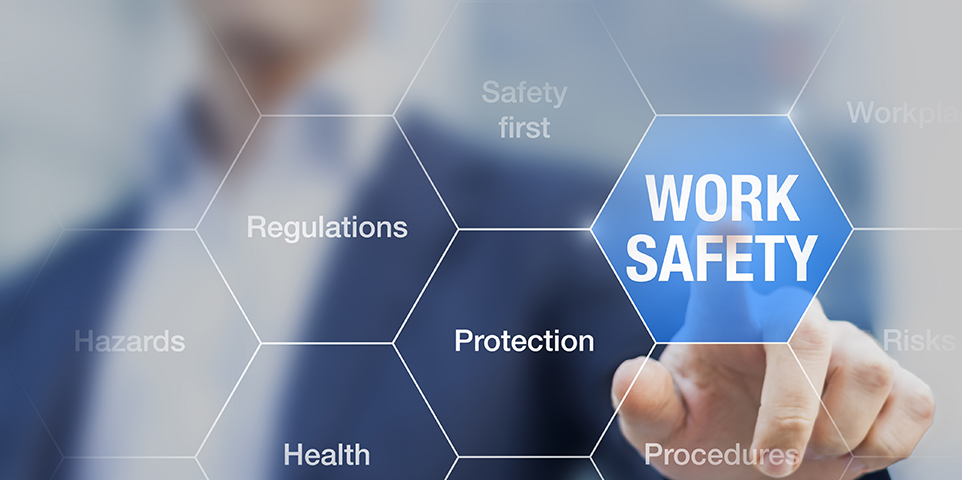
Key Takeaways
- Workplace safety is a shared responsibility that protects employees, reduces costs, and boosts productivity.
- Overexertion, slips/trips/falls, repetitive motion, contact with equipment, falls from heights, exposure to harmful substances, vehicle incidents, and workplace violence are among the most common risks.
- Training, ergonomics, PPE, and equipment maintenance are critical preventive measures.
- Clear protocols, effective hazard communication, and a strong safety culture help reduce incidents and build employee confidence.
- Ongoing vigilance, regular inspections, and adherence to regulations are essential for sustained workplace safety.
- Workplace safety is a fundamental responsibility for every employer and is a key concern for employees across all sectors. From bustling construction sites to quiet office floors, the risk of injuries is ever-present, making it crucial for organizations to adopt a forward-thinking approach to safety. By understanding and proactively addressing the most common causes of workplace injuries, businesses can foster a secure environment where their workforce feels protected. Moreover, reducing workplace injuries lowers injury-related expenses, minimizes absenteeism, and supports long-term productivity. In today’s competitive business landscape, investing in robust safety protocols isn’t simply a regulatory necessity—it’s a practical way to safeguard your employees while strengthening your bottom line. Proactive planning not only keeps everyone safe but also simplifies the process of handling essential coverage like small business workers’ comp, which acts as a critical safety net in the case of unexpected incidents.
- Every year, millions of workers worldwide are affected by preventable workplace accidents. Most incidents fall into a handful of well-known categories, and understanding these primary risks is the first step toward creating a safer workplace. Implementing layered solutions—ranging from policy changes to equipment upgrades—provides comprehensive protection and demonstrates organizational commitment to employee well-being. Beyond regulatory compliance, preventing workplace injuries enhances staff morale, decreases turnover, and boosts a company’s reputation. Read on to discover the most frequent workplace injuries, practical tips for prevention, and guidance on how every business leader can champion a culture of health and safety at work.
Overexertion Injuries
Causes and Risks
Overexertion injuries are among the leading causes of missed workdays, particularly in industries that rely heavily on manual labor. These injuries, which include muscle strains, sprains, and even more severe musculoskeletal disorders, can happen when employees lift, carry, or push heavy objects without proper technique. They may also occur from repetitive tasks that place ongoing strain on the same muscles or joints. Employees working in warehousing, manufacturing, logistics, or landscaping often face a higher risk due to the physical demands of their roles, and insufficient training often exacerbates these vulnerabilities. If left unchecked, overexertion can lead to chronic pain or long-term disability, affecting both employee health and operational efficiency.
Prevention Strategies
- Offer comprehensive training on safe lifting techniques and ergonomic principles to all staff, ensuring that new hires and long-standing employees alike regularly revisit these critical skills.
- Encourage employees to take regular breaks throughout their shifts to prevent fatigue-related incidents, and become proactive in rotating demanding tasks among team members to minimize individual strain.
- Incorporate mechanical aids—such as forklifts, dollies, and conveyor belts—wherever possible to minimize manual handling, significantly reducing the risk of overexertion.
Slips, Trips, and Falls
Causes and Contributing Factors
Slips, trips, and falls account for a significant proportion of workplace injuries each year, from simple bruises to serious fractures or head injuries. These accidents can happen in any setting—offices, factories, retail environments, and outdoor job sites alike. Common hazards include wet or oily floors, loose rugs, uneven walking surfaces, and unseen obstacles like electrical cords or misplaced materials. Inadequate lighting or cluttered passages often exacerbate the situation, obscuring hazards from view. Many of these risks can be easily addressed through housekeeping and employee vigilance, making this one of the most preventable categories of injuries.
Best Practices for Prevention
- Keep all walking surfaces clean and promptly address spills, debris, and clutter to minimize hazards as soon as they arise.
- Ensure that adequate lighting is installed in all areas of the facility, including hallways, stairwells, and storage rooms, to eliminate shadows and dark corners where obstacles may go unnoticed.
- Install handrails on stairs and ramps, and ensure that all walkways remain clear of cables, boxes, and other obstacles that could become tripping hazards.
Repetitive Motion Injuries
Risk Factors
Tasks that involve repeating the same motion over extended periods can lead to repetitive motion injuries, also known as cumulative trauma disorders. Injuries such as carpal tunnel syndrome, tendinitis, and bursitis are common consequences, often resulting from workstations that lack proper ergonomic design. Office workers may develop strains from improper placement of their keyboard or mouse. In contrast, assembly line workers may experience pain in their shoulders, wrists, or elbows due to the monotonous nature of their jobs. Over time, even minor discomfort can escalate into chronic pain and decreased productivity, highlighting the need for preventive action.
[suggestion]An illustration showing various workplace safety measures, such as warning signs, safety gear (helmets, gloves), clear walkways, and proper lifting techniques, representing a safe and organized work environment.[/suggestion]
Mitigation Tactics
- Design workstations according to ergonomic principles, enabling each worker to maintain a neutral body posture while performing tasks, thereby significantly reducing physical strain over time.
- Utilize job rotation or task variation to prevent employees from being exposed to repetitive tasks for prolonged periods, thereby distributing risk across the workforce and promoting overall well-being.
- Incorporate regular stretching and micro-breaks into daily routines to relieve tension, encourage movement, and prevent fatigue or discomfort from setting in.
Contact with Objects and Equipment
Typical Incidents
In environments where machinery and moving equipment are commonplace, injuries caused by contact with objects can be frequent and severe. Falling tools may strike workers, caught between equipment, or accidentally come into contact with moving machinery parts. Such accidents are particularly prevalent in construction, manufacturing, and warehousing industries, where machinery is used daily and materials are constantly handled and transported. Neglecting equipment maintenance or bypassing safety protocols sharply increases the likelihood of accidents, sometimes resulting in serious injuries like fractures, amputations, or even fatalities.
Control Measures
- Provide employees with properly fitting personal protective equipment (PPE), including hard hats, safety goggles, gloves, and steel-toed boots, to mitigate the impact of unexpected contact.
- Perform regular maintenance checks on all equipment and machinery, promptly addressing faults or malfunctions before they escalate into dangerous incidents.
- Implement physical barriers and machine guarding to limit accidental contact, clearly marking hazardous zones and keeping non-essential personnel out of harm’s way.
Falls from Heights
Main Risks
Falls from elevated positions such as ladders, scaffolding, platforms, or rooftops are consistently among the most fatal types of workplace accidents. These incidents are particularly common in the construction and building maintenance sectors, where employees frequently work at heights as part of their regular duties. The risks are magnified by the use of improperly secured equipment, lack of guardrails, or absence of personal fall protection systems. Poorly marked access points or overlooked inspections further increase the chance of a serious injury or fatality.
Prevention Guidelines
- Utilize fall protection equipment, such as harnesses, lifelines, and guardrails, whenever work is performed at elevation, not only meeting but also exceeding industry regulations where possible.
- Inspect ladders, scaffolds, and access points regularly, ensuring they are in stable condition and in good repair, and that any hazards are addressed before work begins.
- Train employees thoroughly on safe climbing, descending, and working procedures at height, incorporating refreshers and drills to maintain high awareness.
Exposure to Harmful Substances
Common Exposure Hazards
Some workplaces regularly expose employees to chemicals, dust, fumes, or other airborne contaminants that can have adverse health effects. These exposures can cause immediate effects like burns or eye irritation, or lead to chronic illnesses after prolonged contact. Employees in manufacturing, laboratories, janitorial services, or agriculture are particularly at risk. Strict adherence to safety guidelines and proactive hazard communication is vital to prevent accidental exposure and to comply with health regulations.
Protection Protocols
- Install high-quality ventilation and air filtration systems to control hazardous airborne substances and maintain safe air quality for all personnel.
- Supply appropriate gloves, respirators, protective clothing, and eyewear tailored to the specific substances or hazards present in the workplace.
- Provide thorough, ongoing training on the correct storage, handling, and disposal of dangerous chemicals.
Vehicle-Related Accidents
Incidents and Risks
Workplace vehicles—from forklifts to delivery vans—are vital in many industries but introduce a unique set of risks. Inadequate operator training, lapses in maintenance, and confusing traffic patterns at the worksite can all lead to collisions, rollovers, or pedestrian injuries. Both indoor and outdoor environments present challenges, with visibility often hampered by layout or weather conditions. Even a momentary lapse in attention can have severe consequences, so vigilance and clear procedures are crucial.
Prevention Initiatives
- Ensure that every operator is certified for their specific equipment, receives regular training updates, and undergoes ongoing skills assessments.
- Establish a strict, regular maintenance program for all work vehicles, addressing any signs of wear or malfunction before they lead to incidents.
- Mark and reinforce clear, well-lit traffic routes on job sites to separate pedestrian and vehicle flow and maximize visibility at all times.
Workplace Violence
Types of Threats
Workplace violence can take many forms, from verbal threats and intimidation to physical altercations. It can impact anyone, regardless of the size or nature of the business. Such incidents not only risk immediate injury but can also have long-term emotional and psychological effects on victims and witnesses. Employers must be vigilant in addressing even subtle signs of negative behavior or hostility in the workplace environment, as unresolved situations can quickly escalate if left unchecked.
Proactive Solutions
- Establish and clearly communicate a zero-tolerance policy for workplace hostility, covering everything from verbal abuse to physical attacks, and ensuring every infraction is addressed promptly.
- Provide training for all employees and managers on de-escalation techniques and conflict resolution, empowering them to handle challenging interactions safely and effectively.
- Establish confidential support and reporting channels to foster a healthy workplace culture and address grievances before they escalate into more serious issues.
Final Thoughts
Reducing workplace injuries is a shared responsibility that pays dividends in employee well-being, morale, and organizational resilience. By staying vigilant and adopting industry best practices, leaders create workplaces where every individual feels secure, valued, and empowered to perform at their best. Organizations that prioritize injury prevention do more than comply with regulations—they demonstrate strong leadership and sound operational strategy, setting themselves apart as employers of choice in their industry.
